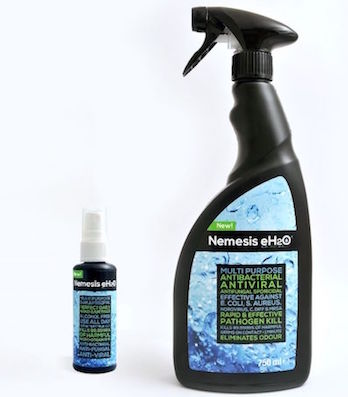 Cleanzine: your weekly cleaning and hygiene industry newsletter 3rd July 2025 Issue no. 1169
Cleanzine: your weekly cleaning and hygiene industry newsletter 3rd July 2025 Issue no. 1169
Your industry news - first
The original and best - for over 20 years!
We strongly recommend viewing Cleanzine full size in your web browser. Click our masthead above to visit our website version.
Disinfectants - why reading the label is vitally important
 As a manufacturer of the disinfectant Nemesis eH2O, Adrian Gee-Turner explains why it is necessary to read a disinfectant's label in order to determine whether it is suitable for the intended application.
As a manufacturer of the disinfectant Nemesis eH2O, Adrian Gee-Turner explains why it is necessary to read a disinfectant's label in order to determine whether it is suitable for the intended application.
Any one of us can walk in to a supermarket and purchase a disinfectant/sanitiser in the confident belief that this product will protect us and our family. However, there are a number of important issues that should be taken into consideration. For example, is that product effective on the target microorganisms? And how quickly does it kill them?
Target microorganisms
Typically, an anti-bacterial sanitiser will offer 99.9% kill of bacteria including Salmonella, Listeria, Influenza and E.Coli. However, the main concern at the moment is of course Covid-19, a virus, so an anti-bacterial sanitiser is not necessarily suited for this purpose.
Contact time
There are of course disinfectants that have proven efficacy against viruses, but in assessing that efficacy it is important to note the contact time required - how long does the product have to be in contact with the virus before it is deactivated? This is important because extended contact times in laboratory tests are not practical in real world situations.
During a viral pandemic, it is important that appropriate surfaces are disinfected with products that quickly and effectively deactivate all of the main problematic pathogens including viruses. This means that all surfaces that are regularly touched should be disinfected, with sufficient contact time. Nemesis eH2O has been tested and shown to deactivate a broad spectrum of pathogens within seconds - this includes Viruses, Influenza, E. Coli, S. Aureus, Norovirus, MRSA, Protozoa and C. Difficile. These tests have shown the ability of Nemesis eH2O to kill 99.9999% of harmful micro-organisms on contact.
Efficacy
The percentage kill for a disinfectant is another vitally important consideration. The difference between 99.9% and 99.9999% may not seem like much, but in fact it means, for example, that Nemesis eH2O is 1,000 times more effective than a disinfectant claiming 99.9%. This is because Logarithmic reduction is the standard used for quantifying disinfection.
For example, healthcare disinfection may require a ≥6-log reduction of test organisms, Staphylococcus aureus, and Pseudomonas aeruginosa in ≥10 minutes. So, a 1-log reduction in colony forming units (CFUs) represents a 90% reduction and 2-log represents a 99% reduction, and so on. 6-log reduction therefore represents a reduction of CFUs by 99.9999%. To put this in perspective, a typical supermarket sanitiser with 99.9% efficacy (3-log) could be expected (in the right conditions) to reduce a colony of 1 million CFUs to 1,000 CFUs - microorganisms capable reproducing quickly. In contrast, a 6-log sanitiser (such as NEMESIS eH2O) would reduce the same size colony down to just one CFU - a dramatic and very significant difference. The lower the efficacy; the greater the need for repeated treatment.
Hand sanitisers
In addition to the disinfection of surfaces that are regularly touched, it is also necessary to disinfect hands - hence the requirement for frequent hand washing. Alternatively, or in addition, alcohol-based hand antiseptics containing ethanol, isopropanol or n-propanol, or a combination thereof can be employed. According to the World Health Organisation, the main advantages of alcohol-based hand sanitisers are that they are fast-acting and broad-spectrum. Also, in a healthcare setting they can overcome the limited availability of taps and washbasins.
Alcohol solutions containing 60-80% alcohol are most effective, with higher concentrations being less potent. Alcohols have excellent in vitro germicidal activity against Gram-positive and Gram-negative vegetative bacteria and a variety of fungi. However, they have virtually no activity against bacterial spores or protozoan oocysts, and very poor activity against some non-enveloped (non-lipophilic) viruses.
Frequent use of alcohol-based formulations for hand antisepsis tends to cause drying of the skin unless humectants or other skin conditioning agents are added to the formulations. However, even well-tolerated alcohol-based handrubs containing humectants may cause a transient stinging sensation at the site of any broken skin. Alcohols are also flammable so appropriate safety precautions are necessary.
A major advantage of Nemesis eH2O, is that is it pH neutral and in addition to surfaces it can also be applied to skin; even sensitive skin, and with no alcohol it does not cause any damage or cracking of the skin after frequent use.
Summary
As outlined above there a number of important issues to be considered when choosing a disinfectant:
1. Does the product have sufficient efficacy against relevant pathogens?
2. How fast are the pathogens killed?
3. What is the efficacy in terms of %age kill?
4. Is the product safe for use in terms of toxicity and flammability?
5. Is it easy to use on all surfaces? (and skin)
Nemesis eH2O performs extremely well in such a detailed assessment of disinfectant labels, and as such represents the ideal solution for disinfection in a wide range of applications including health care, domestic use, food processing and animal housing. As of today, 750ml bottles of the product have been added to the Boots UK online store.
14th May 2020







